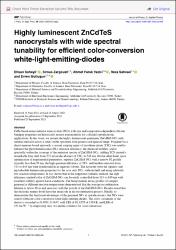| dc.contributor.author | Soheyli, Ehsan | |
| dc.contributor.author | Zargoush, Sirous | |
| dc.contributor.author | Yazici, Ahmet Faruk | |
| dc.contributor.author | Sahraei, Reza | |
| dc.contributor.author | Mutlugun, Evren | |
| dc.date.accessioned | 2022-02-17T06:40:34Z | |
| dc.date.available | 2022-02-17T06:40:34Z | |
| dc.date.issued | 2021 | en_US |
| dc.identifier.issn | 0022-3727 | |
| dc.identifier.issn | 1361-6463 | |
| dc.identifier.uri | https //doi.org/10.1088/1361-6463/ac26f5 | |
| dc.identifier.uri | https://hdl.handle.net/20.500.12573/1154 | |
| dc.description.abstract | CdTe-based semiconductor nanocrystals (NCs) with size and composition-dependent efficient bandgap properties are historically mature nanomaterials for colloidal optoelectronic applications. In this work, we present the highly luminescent quaternary ZnCdTeS NCs with tunable emission across a wide visible spectrum from green to red spectral range. Prepared via a direct aqueous-based approach, a second capping agent of trisodium citrate (TSC) was used to enhance the photoluminescence (PL) emission efficiency, the chemical stability, and to spectrally widen the coverage of the emission spectra of ZnCdTeS NCs. Adding TCS created a remarkable blue shift from 572 nm in the absence of TSC, to 548 nm. On the other hand, upon optimization of experimental parameters, superior ZnCdTeS NCs with a narrow PL profile typically less than 50 nm, the high quantum efficiency of 76%, and tunable emission from 515-to-645 nm were synthesized in an aqueous solvent. The keynotes were the superior and reproducible luminescent properties for the core only NCs, without shell and using relatively low reaction temperatures. It was shown that in the suggested synthesis method, the high efficiency emitted color of ZnCdTeS NCs can be easily controlled from 515-to-650 nm with excellent stability against harsh conditions. The biexponential decay profiles of samples prepared at different reaction temperatures demonstrated that the average recombination lifetime is below 40 ns and increases with the growth of the ZnCdTeS NCs. Results reveal that the excitonic energy levels have the main role in the recombination process. Finally, to demonstrate the functional advantages of the prepared NCs in optoelectronics, the NCs were used to fabricate color-conversion white light-emitting diodes. The color coordinate of the device is recorded as (0.4951, 0.3647) with CRI of 91, CCT of 1954 K, and LER of 251 lm W-1 by employing only two distinct emitters for color conversion. | en_US |
| dc.language.iso | eng | en_US |
| dc.publisher | IOP PUBLISHING LTDTEMPLE CIRCUS, TEMPLE WAY, BRISTOL BS1 6BE, ENGLAND | en_US |
| dc.relation.isversionof | 10.1088/1361-6463/ac26f5 | en_US |
| dc.rights | info:eu-repo/semantics/openAccess | en_US |
| dc.subject | white LED | en_US |
| dc.subject | PL lifetime | en_US |
| dc.subject | wide tunable emission | en_US |
| dc.subject | high quantum efficiency | en_US |
| dc.subject | ZnCdTeS nanocrystals | en_US |
| dc.title | Highly luminescent ZnCdTeS nanocrystals with wide spectral tunability for efficient color-conversion white-light-emitting-diodes | en_US |
| dc.type | article | en_US |
| dc.contributor.department | AGÜ, Mühendislik Fakültesi, Elektrik - Elektronik Mühendisliği Bölümü | en_US |
| dc.contributor.authorID | 0000-0003-2747-7856 | en_US |
| dc.contributor.institutionauthor | Yazici, Faruk Ahmet | |
| dc.contributor.institutionauthor | Mutlugun, Evren | |
| dc.identifier.volume | Volume 54 Issue 50 | en_US |
| dc.relation.journal | JOURNAL OF PHYSICS D-APPLIED PHYSICS | en_US |
| dc.relation.publicationcategory | Makale - Uluslararası - Editör Denetimli Dergi | en_US |


















